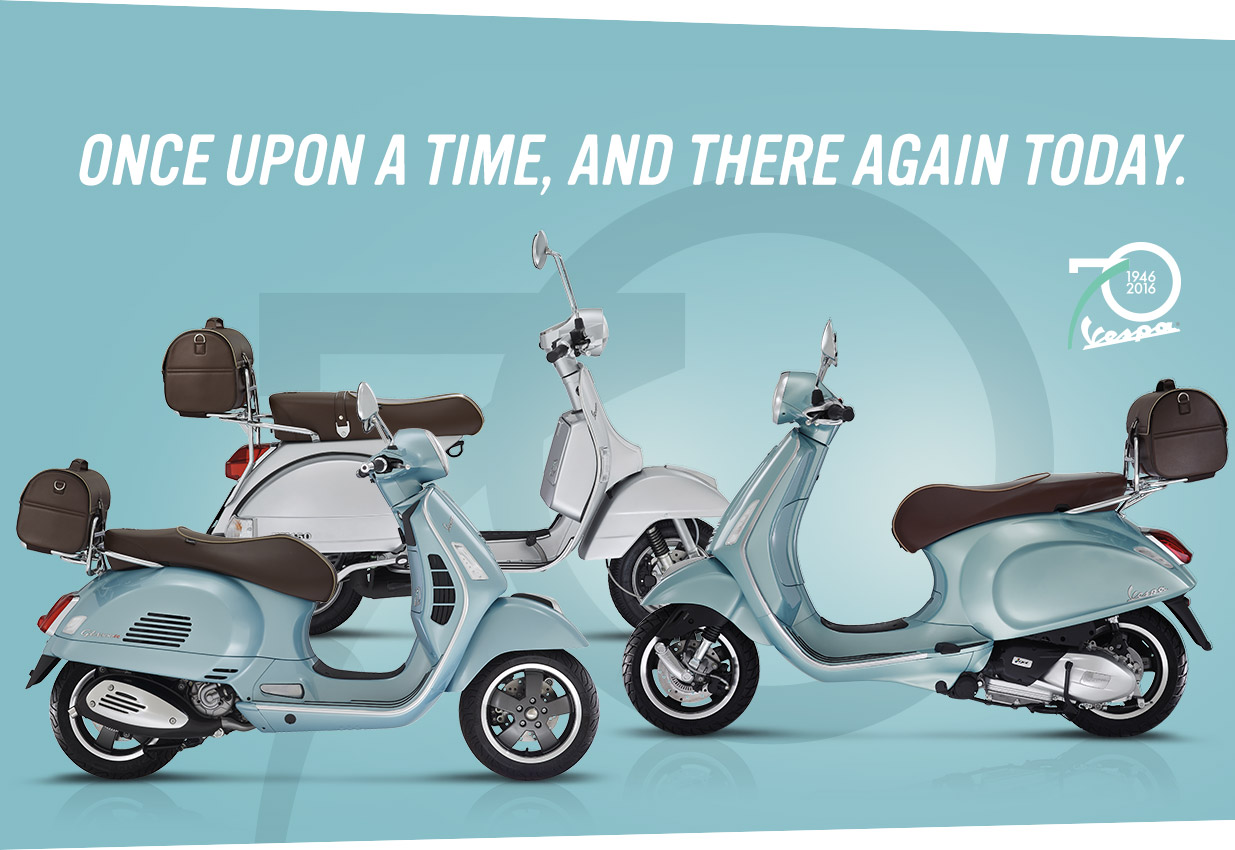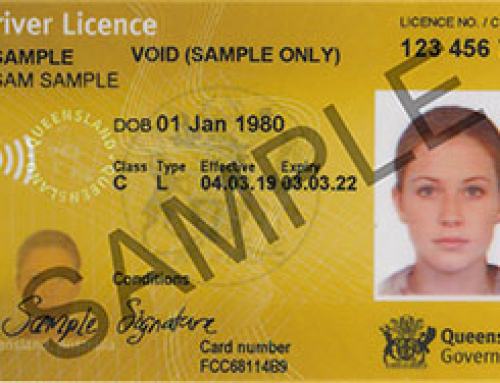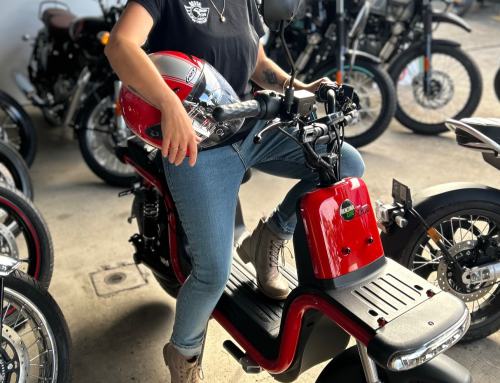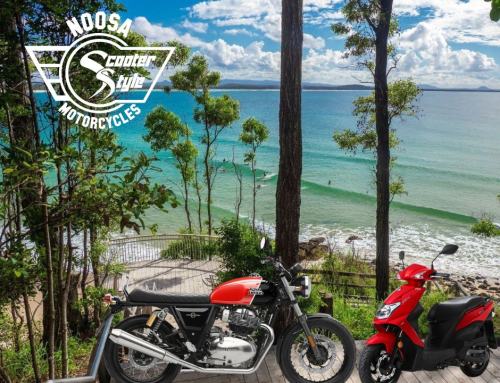Vespa from 1951 to 1960
We have decided to celebrate 70 years of Vespa with a monthly chronicle of the History of Vespa from 1946 to 2016!
This month we are starting with the record-breaking Vespa Siluro (Torpedo) in 1951 to the unparalleled Vespa 150 GS VS5 in 1959.
Each month, we will post up a little history and pop it in our newsletter so you can find out a little more of the history of this iconic brand.
VESPA SILURO (TORPEDO) 1951
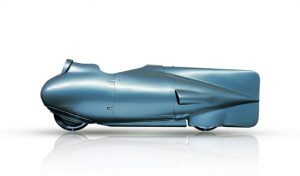 In 1951, Vespa broke its most prestigious record: the flying kilometre.
In 1951, Vespa broke its most prestigious record: the flying kilometre.
On the 9th of February, between the 10th and the 11th kilometre of the motorway of Rome (near to Ostia) a Vespa engine with two opposed pistons (power: 17.2 hp and 9500 rpm), designed by Corradino D’Ascanio, and led by Dino Mazzoncini, run the flying kilometre with a record time of 21 seconds and 4 cents with is an average speed of 171.1 km / h.
VESPA 125 1951
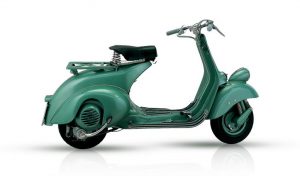 Very similar to the pattern of 1948, the sales during 1951 where on the increase due to improved technology and aesthetics.
Very similar to the pattern of 1948, the sales during 1951 where on the increase due to improved technology and aesthetics.
The model of 1951 even became famous in its cinema debut in the romantic and unforgettable movie Roman Holiday which told the love story of Audrey Hepburn and Gregory Peck in Rome.
VESPA 125 “SIX DAYS” 1951
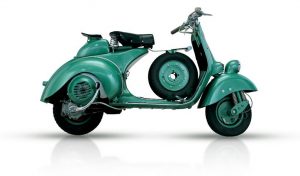 Aesthetically very similar to Vespa 125, the “Six Days” differed due to the fuel tank benefiting of a wraparound shield and the right side bag which accommodated a larger carburetor. The name came from the participation at the Twenty-sixth International Six Days in 1951, in which nine gold medals where won. The Piaggio Racing Team was composed of: Biasci, Cau, Crabs, Mazzoncini, Merlo, Nesti, Opesso, Riva, Romano and Vivaldi. The Vespa 125 “six days” also won the trophy of the Italian Motorcycle Federation in 1951, which saw three riders dominate on Italian Vespas (Giuseppe Cau, Miro Riva, Bruno Romano).
Aesthetically very similar to Vespa 125, the “Six Days” differed due to the fuel tank benefiting of a wraparound shield and the right side bag which accommodated a larger carburetor. The name came from the participation at the Twenty-sixth International Six Days in 1951, in which nine gold medals where won. The Piaggio Racing Team was composed of: Biasci, Cau, Crabs, Mazzoncini, Merlo, Nesti, Opesso, Riva, Romano and Vivaldi. The Vespa 125 “six days” also won the trophy of the Italian Motorcycle Federation in 1951, which saw three riders dominate on Italian Vespas (Giuseppe Cau, Miro Riva, Bruno Romano).
VESPA 125 U 1953
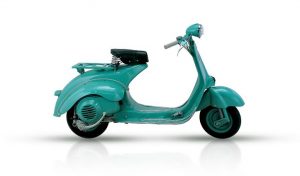 Only 7,000 copies of the Vespa U scooter were ever produced, making this model one of the most sought after by collectors. Created in 1953 as the economic model – the letter “U” stands for utility – it was designed to counteract Lambretta’s competition and got sold on the market for 110 dollars.
Only 7,000 copies of the Vespa U scooter were ever produced, making this model one of the most sought after by collectors. Created in 1953 as the economic model – the letter “U” stands for utility – it was designed to counteract Lambretta’s competition and got sold on the market for 110 dollars.
For the first time the headlight was mounted at the height of the handlebars instead of the front fender.
VESPA 150 SIDE-CAR 1955
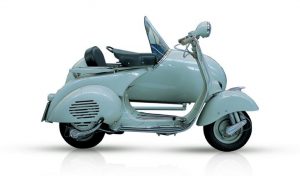 The Vespa sidecar was created between the late 1948 and the early 1949. The Vespa with sidecar enabled a stable and comfortable travel over long distances. The sidecar was made of sheet steel and was assembled by hand and attached to the Vespa with a single tube. Commended for their excellent performance, even on snowy terrain and on steep slopes, the side-car model dictated itself to comfort, additional capacity thanks to a small trunk at the rear and the additional convenience on long pursuits.
The Vespa sidecar was created between the late 1948 and the early 1949. The Vespa with sidecar enabled a stable and comfortable travel over long distances. The sidecar was made of sheet steel and was assembled by hand and attached to the Vespa with a single tube. Commended for their excellent performance, even on snowy terrain and on steep slopes, the side-car model dictated itself to comfort, additional capacity thanks to a small trunk at the rear and the additional convenience on long pursuits.
VESPA 150 GS 1955
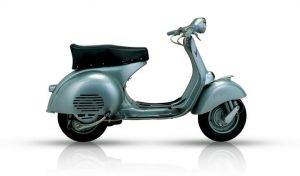 The 150 GS was a milestone in the history of the scooter, not only for Vespa but for the whole market. It is remembered as the most beautiful scooter ever produced in the world and is now highly sort after. In the 50’s the market also changed and Vespa became a symbol for young people to distinguish themselves. For the first time a vehicle for the mass market was created with a quieter engine and breathtaking performances. The Vespa 150 GS had sports credentials which where a direct result of the experience of the Piaggio racing team. The engine had a direct admission into the cylinder and was capable of 8 hp at 7500 rpm, the gearbox had four gears. The elongated seat and the large 10-inch wheels fundamentally altered the Vespa line. A pre-series version of this model is now on display at the Piaggio Museum.
The 150 GS was a milestone in the history of the scooter, not only for Vespa but for the whole market. It is remembered as the most beautiful scooter ever produced in the world and is now highly sort after. In the 50’s the market also changed and Vespa became a symbol for young people to distinguish themselves. For the first time a vehicle for the mass market was created with a quieter engine and breathtaking performances. The Vespa 150 GS had sports credentials which where a direct result of the experience of the Piaggio racing team. The engine had a direct admission into the cylinder and was capable of 8 hp at 7500 rpm, the gearbox had four gears. The elongated seat and the large 10-inch wheels fundamentally altered the Vespa line. A pre-series version of this model is now on display at the Piaggio Museum.
VESPA 150 1956
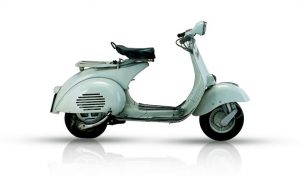 In 1956, ten years after the birth of the first model, the Pontedera factory achieved the millionth Vespa sale. The success of Vespa went beyond all expectations: the legendary scooter got then offered in three versions: 125cc, 150cc and the 150cc GS.
In 1956, ten years after the birth of the first model, the Pontedera factory achieved the millionth Vespa sale. The success of Vespa went beyond all expectations: the legendary scooter got then offered in three versions: 125cc, 150cc and the 150cc GS.
The Vespa 150 provided improved performance and it also stood out due to the headlamp mounted high above the handlebars. The launch price of the Vespa 150 in 1956 was 148,000 lire.
VESPA 150 T.A.P. 1956
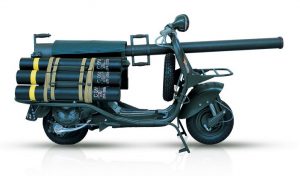 The French Ministry of Defence, in the fifties, commissioned by the licensee in Piaggio France (ACMA) requested the development of a vehicle for military use.
The French Ministry of Defence, in the fifties, commissioned by the licensee in Piaggio France (ACMA) requested the development of a vehicle for military use.
The result was a very special Vespa of which there were only about 600 produced from 1956 to 1959. Used by the Foreign Legion and the Parachute Corps, the Vespa T.A.P. was equipped with a 75mm gun, capacity for additional ammunition, two cans of fuel and a small cart. It was produced in two camouflage colours: green and sand. Despite a weight of 115kg, the Vespa T.A.P. could reach a speed of 66 km/h, with a range of 200 km.
VESPA 400 1957
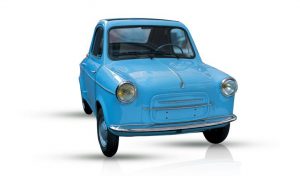 At the peak of Vespa’s success, Piaggio decided to access the four wheels world.
At the peak of Vespa’s success, Piaggio decided to access the four wheels world.
It was always the goal of Corradino D’Ascanio to design the small Vespa 400, a car with a two-stroke engine in the rear.
It was launched in 1957 and Piaggio produced 30,000 units of this model.
VESPA 125 (VNA2) 1958
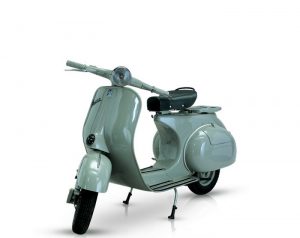 Produced in two colours, grey and beige, the 1958 Vespa 125cc marked an era.
Produced in two colours, grey and beige, the 1958 Vespa 125cc marked an era.
This was the first Vespa with a body which was made by the conjunction of two sheet metal halves. This type of frame had considerable advantages in terms of industrial production and from 1958 started to be used on all models. With the new design a new compact engine was also integrated.
VESPA 150 GS VS5 1959
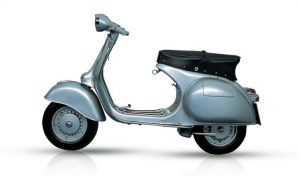 The legendary Vespa 150 Gran Sport established itself in 1955 with the model VS1. This model was adapted and the VS5 version was equipped with a special speedometer fan and a fully chromed tail light with integrated brake light.
The legendary Vespa 150 Gran Sport established itself in 1955 with the model VS1. This model was adapted and the VS5 version was equipped with a special speedometer fan and a fully chromed tail light with integrated brake light.
It also had an improved braking system and the Piaggio crest on the front fender. The Vespa 150 GS (VS5) model holds the record for the number of units built (80 000) and was produced between 1958 and 1961.
You can check out our range of Vespa models by clicking here and for more information on the Vespa 70° Anniversary, click here.


